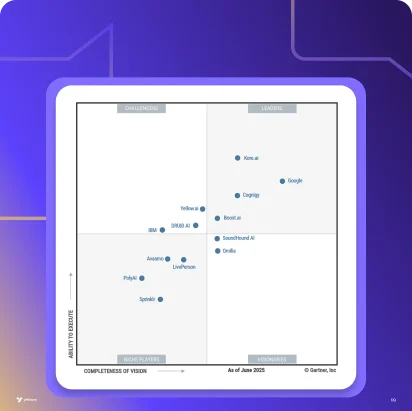Yellow.ai’s Copilot is a powerful tool that helps you improve the performance of your AI agent. It allows you to debug, optimize, and adjust your agent’s responses, ensuring they work as expected. In this blog, we’ll show you how to use Copilot to make your AI agent more accurate and effective.
Watch CoPilot in Action
Watch how AI CoPilot can simplify your agent debugging process:
Getting Started with Copilot
1. Enter Your Intent
To start using Copilot, go to the Yellow.ai Cloud Platform and navigate to Automation > Copilot. In the input chat field, type the intent for your AI agent. This could be a query or task that you want your agent to handle. Only intents added to your conversation, small talk, or knowledge base questions will work here.
Example:
If you want the agent to help users book a demo, you can type: “Book a demo.” The system will then look for this intent in your configuration and begin analyzing it.
Once you enter the intent, you can look at Traces to see how the system processes the user’s inputs and generates actions. Traces help you understand how the conversation flows and give you the chance to improve it.
2. View Traces for More Details
Traces provide a detailed view of the entire conversation process. By clicking Show Trace, you can see:
- How the system understands user inputs.
- The actions that the AI generates based on the conversation context.
- The responses the AI creates to answer user queries.
Example:
If a user asks, “Can I book a demo?” Copilot will show you how the agent interprets this question and what actions it takes (e.g., triggering the demo booking flow). You can then decide if the response needs adjustment.
What Actions Can You Take?
Copilot suggests different actions to improve your AI agent based on the context of the conversation. If the agent doesn’t respond well when a user asks, “Can you help me analyze this report?” you might choose the Upload Document option to prompt the user to upload the report. Alternatively, you could Edit the Trigger to make the agent respond specifically to this type of question.
These are some of the key actions you can take:
| Action | Description |
|---|---|
| Upload Document | If the conversation involves a file (e.g., reviewing a resume or report), this action prompts the user to upload a document. |
| Edit Trigger | Adjust the conditions that start a conversation. This ensures the agent responds correctly to user queries. |
| Edit Conversation Prompt | Modify how the agent interprets the user’s query. If the response isn’t accurate, you can change the prompt to improve it. |
Understanding the Agent’s Response
Copilot helps you understand how your AI agent processes user messages and creates responses. If a user enters, “Schedule a meeting for tomorrow,” Copilot will show the following:
- User Message Received: “Schedule a meeting for tomorrow”
- Agent Prompt: “Sure, I can help with that. Let me know the time.”
- Agent Config: Includes parameters like date parsing tools, calendar integrations, etc.
This breakdown helps you see how the agent handles specific messages and whether adjustments are needed.
Here’s what you can optimize:
| Component | Description |
|---|---|
| User Message Received | Shows the original message from the user (e.g., “Book a demo”). |
| Agent Prompt | Displays the prompt that guides the agent’s response. |
| Agent Config | Contains configuration details, such as API version, models, and parameters. |
| Agent History | Tracks the sequence of messages exchanged during the conversation. |
| Agent Response | Displays the response the agent gives to the user’s message. |
| Agent Reasoning | Explains why the agent gave a specific response. |
| Predicted Tools | Lists tools or APIs the system thinks will be needed for the task. |
| Token Usage | Shows how many tokens were used during the conversation, helping monitor performance. |
Improving the Conversation Flow
Copilot also lets you analyze the flow of the conversation. It helps you see how the conversation is structured and how responses are generated. You can get insights into:
| Component | Description |
|---|---|
| Conversation Prompt | Shows the first prompt that starts the conversation. |
| Conversation Config | Lists the settings and parameters that control the conversation. |
| Conversation History | Tracks all messages exchanged, ensuring everything stays on track. |
| Token Usage | Keeps track of the tokens used in the conversation. |
| Conversation Response | Displays the response generated for the user’s query. |
| Conversation Reasoning | Explains the logic behind the agent’s response, making sure it fits the context. |
How Yellow.ai’s AI copilot can simplify your AI Agent Debugging process?
Yellow.ai’s Copilot is more than just a debugging tool. It’s designed to help you improve how your AI agent interacts with users. By using traces and conversation insights, you can adjust your agent’s behavior to ensure it works correctly and meets user needs. With Copilot, you can create better, more reliable AI conversations.





















